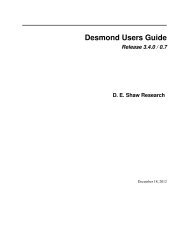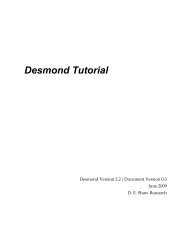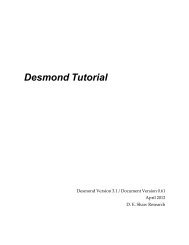Desmond Tutorial
Desmond Tutorial - DE Shaw Research
Desmond Tutorial - DE Shaw Research
- No tags were found...
You also want an ePaper? Increase the reach of your titles
YUMPU automatically turns print PDFs into web optimized ePapers that Google loves.
<strong>Desmond</strong> <strong>Tutorial</strong><br />
<strong>Desmond</strong> <strong>Tutorial</strong><br />
Figure 1.7 Protein Preparation Wizard<br />
Check these options:<br />
– ‘Assign bond orders’<br />
– ‘Add hydrogens’<br />
– ‘Treat metals’<br />
– ‘Delete waters’ (set the<br />
distance to a small value<br />
to remove all water<br />
molecules)<br />
Click the ‘Preprocess’<br />
button.<br />
10. In the Preprocess and analyze structure section, check these options:<br />
— Assign bond orders<br />
NOTE<br />
— Add hydrogens<br />
— Cap termini. Set this option if you want the N or C termini capped. There are<br />
many capping groups available; the most common are ACE on the N terminus<br />
and NMA on the C terminus.<br />
— Detect disulfide bonds. The 4pti structure has three disulfide bonds, which are all<br />
correctly recognized by the Protein Preparation Wizard.<br />
— Delete waters. Set this option if you have a reason to remove crystal waters. Set<br />
the distance to a small value to remove all water molecules. “Het groups” refers<br />
to atoms that are labeled HETATM in a PDB file (anything that is not a protein<br />
residue or water).<br />
In most cases crystal waters should not be removed from the interior of the protein molecule,<br />
or near the protein surface. These water molecules are crucial structural components<br />
of the protein and cannot be adequately reproduced by the algorithm used to<br />
solvate the system later on.<br />
8 D. E. Shaw Research September 2008






